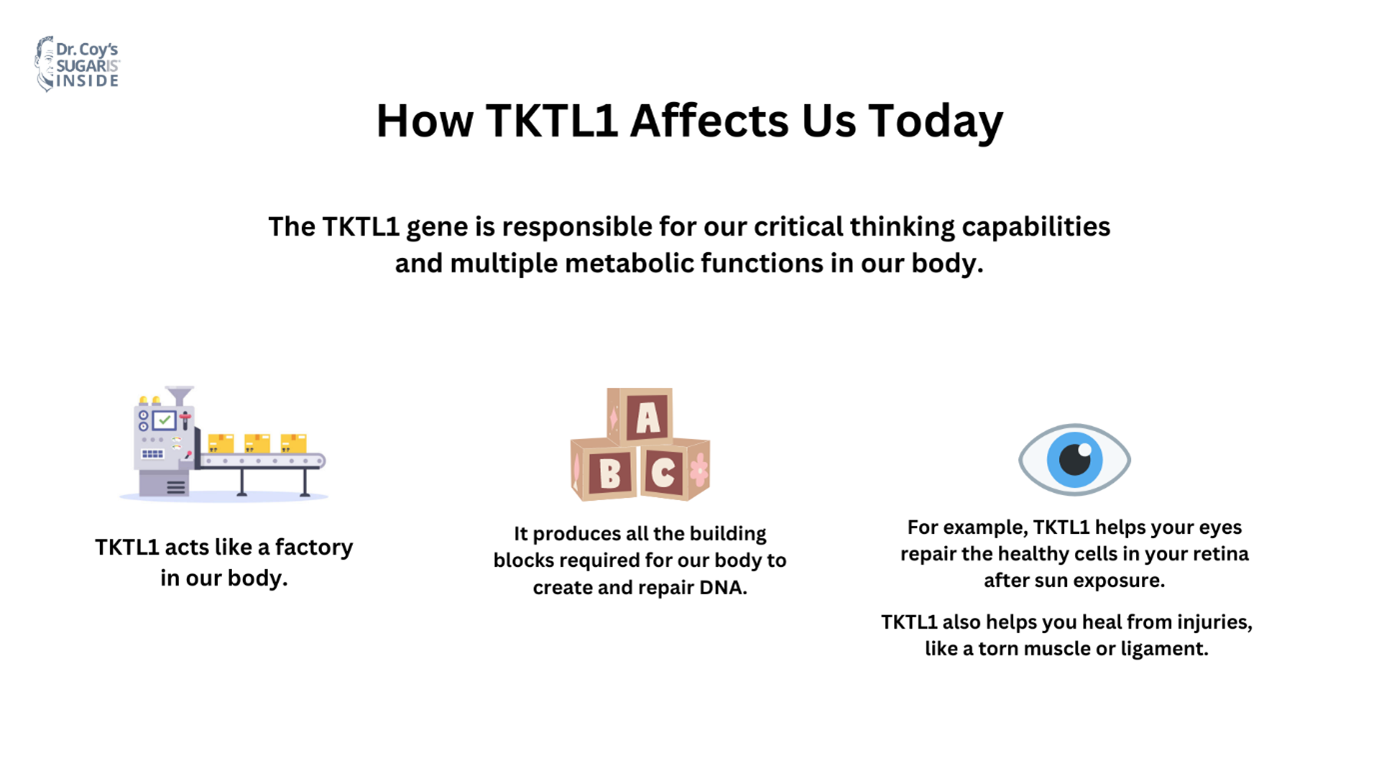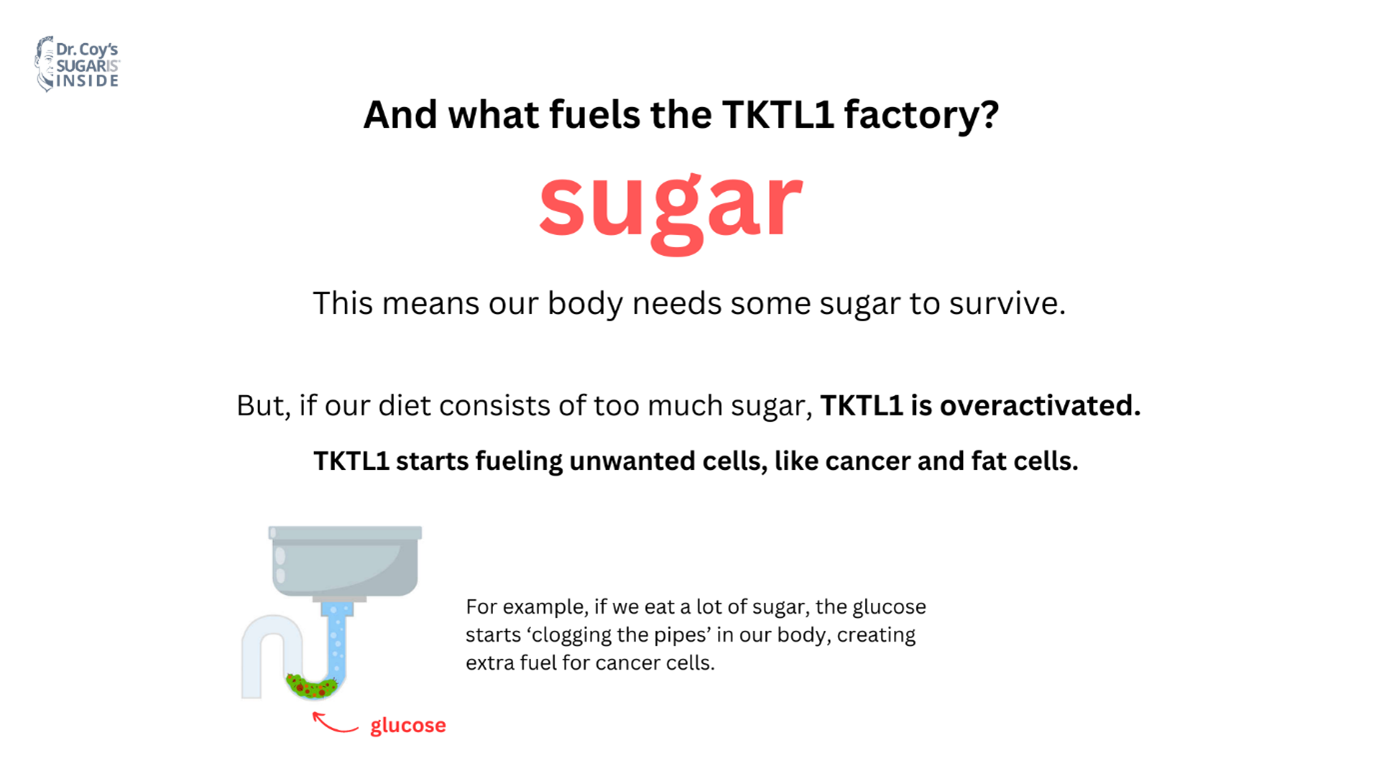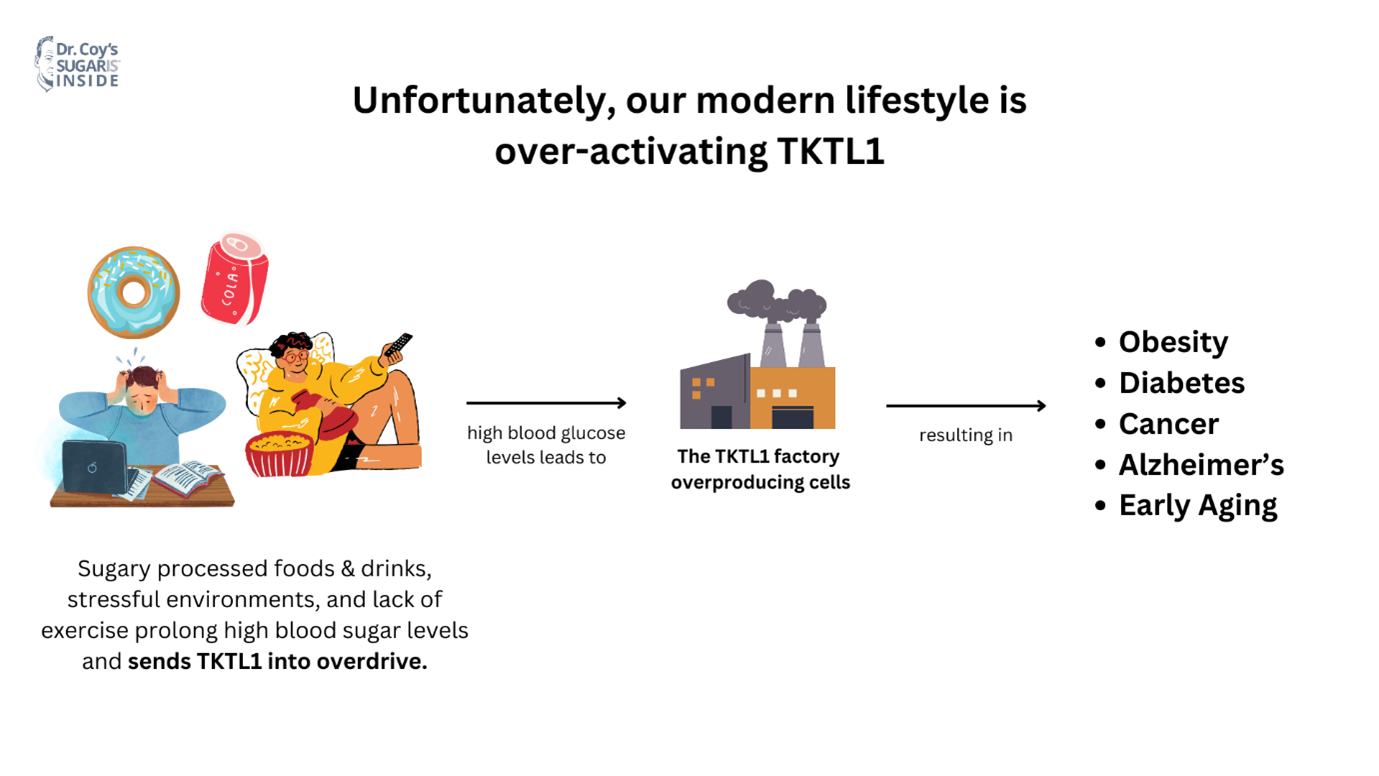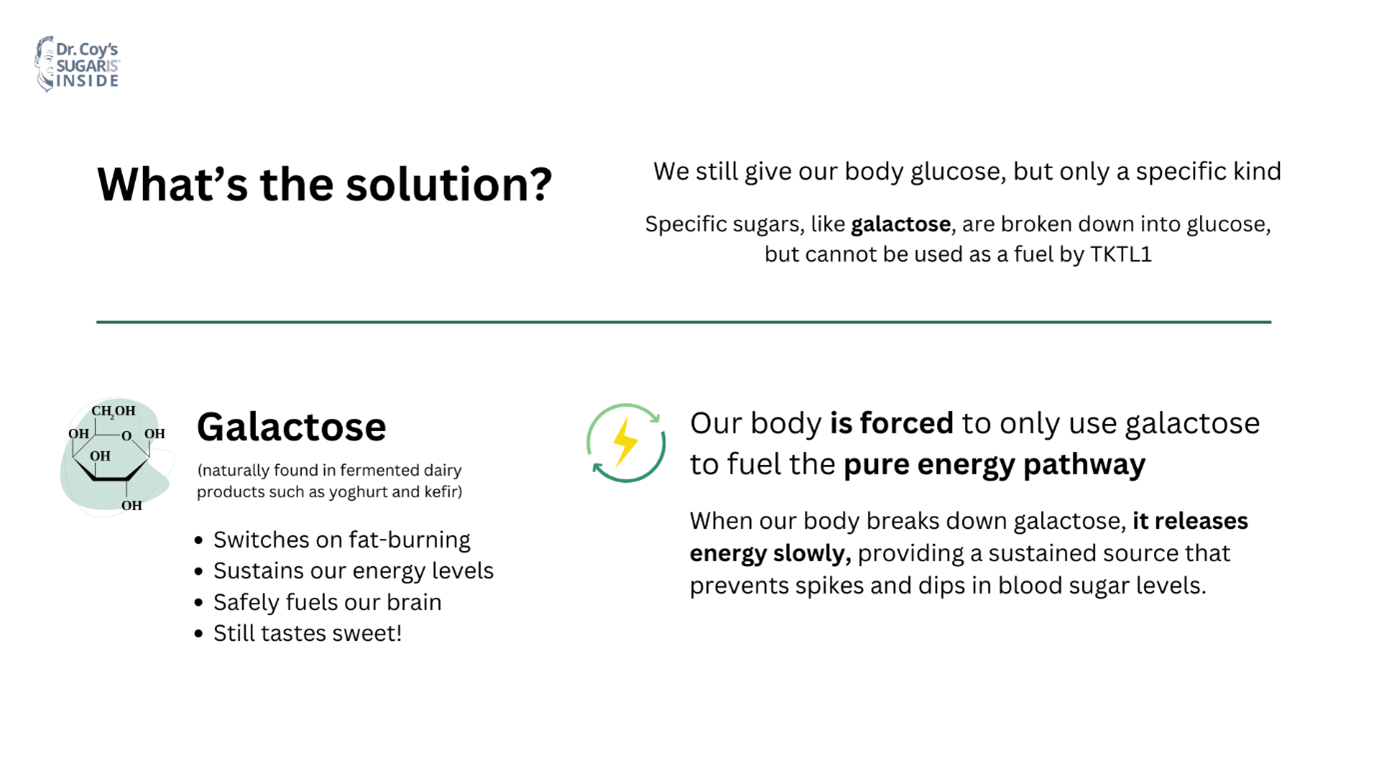Unlocking TKTL1 – Part 2: How does TKTL1 affect us today?
This incredible gene, responsible for our advanced capabilities as humans, is backfiring in our modern lifestyles.
So, how does TKTL1 function in the body?
TKTL1 acts like a factory. It produces all the building blocks our body requires to create and repair new cells. For example, TKTL1 helps your eyes repair the healthy cells in your retina after sun exposure. It can help you heal from injuries, like a torn muscle or ligament, and promote the function of stem cells to repair cartilage.
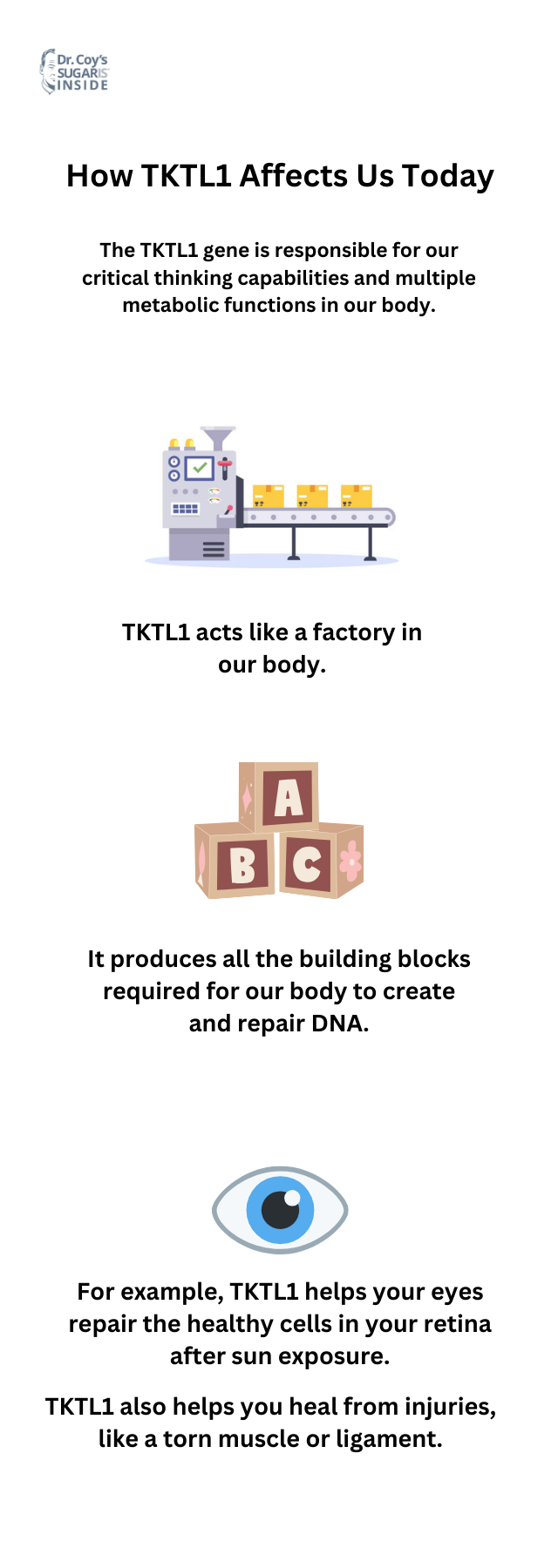
Every factory needs a fuel source. And what fuels the TKTL1 factory? Sugar.
This means our body requires sugar to survive – whenever we consume savoury carbs or something sweet, like pasta or chocolate, our body processes the glucose into energy. Since starches and proteins also contain sugar, it’s not just sweet tasting foods that release glucose.
Without sugar, our body would not be able to create and repair new cells. This is why our brain tells us to eat sugar or carbohydrates releasing glucose.
The problem is, classic sugars and carbohydrates release glucose very quickly, which spike blood glucose levels in a dangerous way.
If our diet consists of too much glucose, the TKTL1 factory is overactivated. Just like if you give an engine too much gas, it overheats and starts producing more energy than needed. Similarly, with too much sugar, the TKTL1 factory starts producing unwanted cells, like fat and cancer cells.
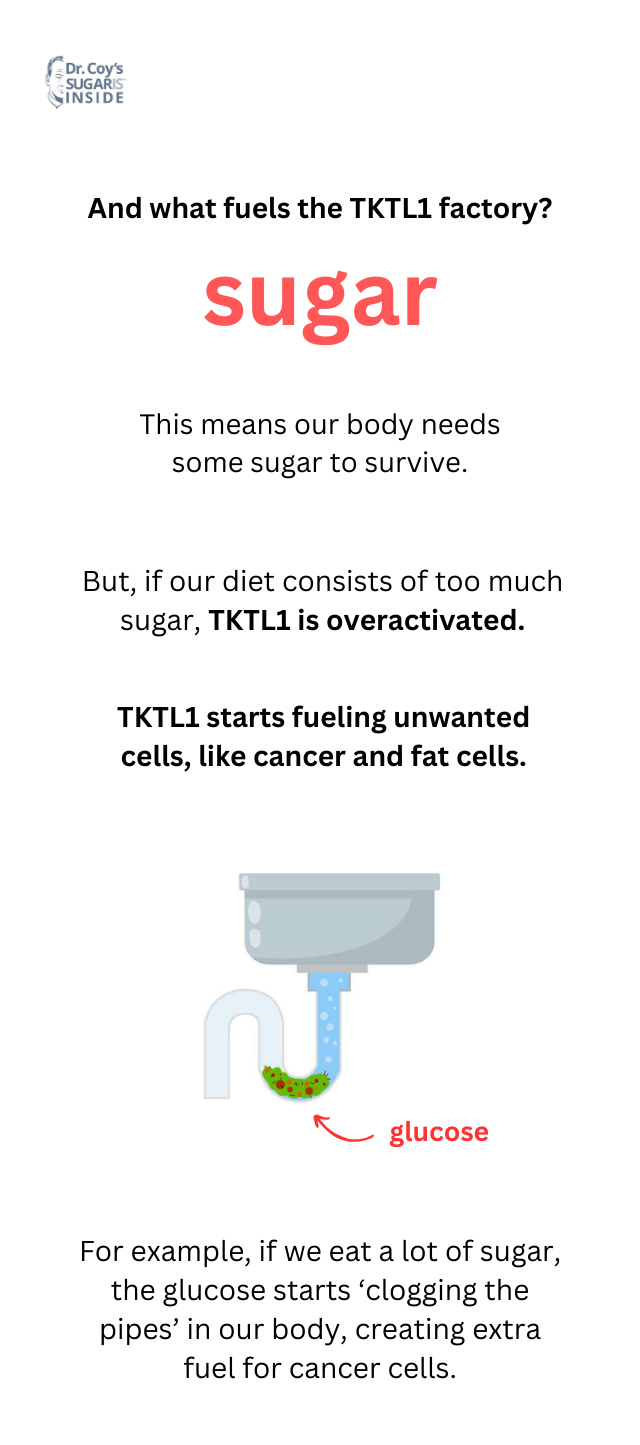
TKTL1 and sugar are intrinsically linked, they are like two sides of a coin, with a good side and a bad side.
On the good side, TKTL1 uses sugar to fuel our brain and repair our body. We need balanced blood sugar levels for sustained energy levels to feel alert throughout the day. Sugar helps maintain cognitive clarity, supports critical thinking in the neocortex and protect the hippocampus, the memory centre in our brain.
On the flip side, are the negative effects. Diseases like cancer, are incredibly smart, and can overtake TKTL1’s factory to create and duplicate cancer cells.
High blood sugar levels trigger fat cells, leading to weight gain and diabetes. Prolonged high blood sugar levels promote high insulin levels – until finally our body develops an insulin resistance or hyperinsulinemia. This starves the brain of energy, triggering Alzheimer’s disease.
Since glucose cannot be taken up by the hippocampus, not enough glucose is present to keep the nerve cells alive. Unfortunately, TKTL1 does not have enough fuel to protect the hippocampus and our memories, which explains why high blood sugar levels are causing dementia and Alzheimer’s.
New cutting-edge technology is using the strongly reduced uptake and metabolism of glucose in the brain for the early detection of Alzheimer’s. The aim is to detect Alzheimer’s many years before the onset of the disease, based on the glucose uptake.
Deoxyglucose, a special type of glucose very similar to normal glucose, is radioactively labelled. If low amounts of this radioactive sugar reach the brain, it is a clear sign of the first steps towards Alzheimer’s.
The same technique is being used for the detection of cancer. In this case, the high uptake of glucose is indicating cancer.
As you can see, glucose is linked to the majority of prevalent lifestyle diseases in our society.
Because our modern diet consists of so much sugar, from processed foods to sodas, combined with a lack of exercise and stressful environments, the TKTL1 factory is constantly over-activated in our body.
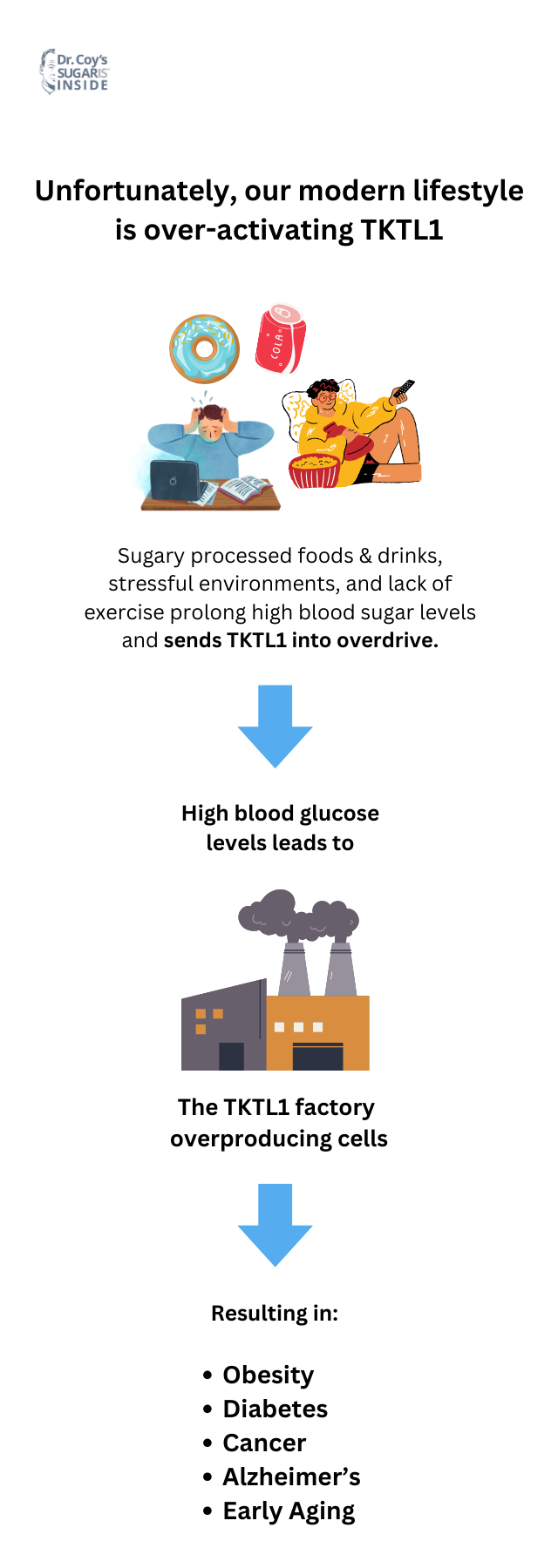
TKTL1 and The Intelligent Sugar Strategy
So how can we keep the TKTL1 factory running smoothly?
We need to give TKTL1 the right amount of fuel: a balanced amount of specific mixtures of sugar. Staying away from sugar is difficult when we’re craving something sweet, and cutting out sugar completely isn’t a healthy option either.
Just like you, Dr Coy realized we can’t give up birthday cakes, desserts, and late-night chocolates that bring us happiness. He knew there was a way to indulge in sugar and still protect and repair our body.
By using specific ratios of natural sugars extracted from plants, honey, and milk, Dr Coy developed an Intelligent Sugar Strategy.
A way to still enjoy sugary sweetness, without disrupting the balance of the TKTL1 factory. By giving your body the right amount of glucose for your lifestyle needs, you can keep your blood sugar levels stable. Dr Coy created specific mixtures for a healthy, everyday lifestyle, an athlete’s training routine, and weight loss goals.
For example, there is a rare sugar called galactose derived from milk sugar (lactose). It is naturally found in fermented dairy products such as yoghurt and kefir and in very small quantities in artichokes, mushrooms, and tomatoes.
Even though galactose is a form of sugar, which tastes sweet and gives us energy, it cannot be used as a fuel source by TKTL1. Since TKTL1 can’t use galactose, it is not able to create or repair unwanted cells, like cancer cells.
Here’s how it works: since galactose cannot be utilized by TKTL1, the body is forced to use it for the combustion engine to create energy, called the mitochondria. Galactose activates this combustion engine, which leads to an increase in oxygen consumption. Think of the combustion engine like a fire, it needs oxygen to burn.
This switch to the combustion engine enhances fat mobilization and fat burning because it requires the body to burn energy. Which means you can switch on fat burning whilst eating, simply by consuming foods containing galactose.

Galactose can even help support cancer treatments. Therapies like chemo- and radiotherapy work hard to attack the cancer cells, and with galactose, TKTL1 is prevented from giving the cancer cells fuel to repair and duplicate.
But, to create and repair healthy cells, TKTL1 still needs some glucose. It cannot use galactose. Which is why your body requires a balance of different sugars, to safely consume glucose. For example, breastmilk has the perfect ratio of glucose, galactose, and tagatose to strengthen a baby’s growth and health.
Dr Coy developed these specific sugar mixtures to help keep the TKTL1 factory balanced in our modern lifestyle. By keeping blood sugar levels stable, and giving TKTL1 the optimal amount of fuel, you can start to see massive shifts in your overall wellness.
Are you ready for an Intelligent Sugar Strategy?
Resources:
Li M, Zhao X, Yong H, Xu J, Qu P, Qiao S, Hou P, Li Z, Chu S, Zheng J, Bai J. Transketolase promotes colorectal cancer metastasis through regulating AKT phosphorylation. Cell Death Dis. 2022 Feb 2;13(2):99. doi: 10.1038/s41419-022-04575-5. PMID: 35110545; PMCID: PMC8810869.
Zhu, Y., Qiu, Y. & Zhang, X. TKTL1 participated in malignant progression of cervical cancer cells via regulating AKT signal mediated PFKFB3 and thus regulating glycolysis. Cancer Cell Int 21, 678 (2021).
Hao S, Meng Q, Sun H, Li Y, Li Y, Gu L, Liu B, Zhang Y, Zhou H, Xu Z, Wang Y. The role of transketolase in human cancer progression and therapy. Biomed Pharmacother. 2022 Oct;154:113607. doi: 10.1016/j.biopha.2022.113607. Epub 2022 Aug 26. PMID: 36030587.

